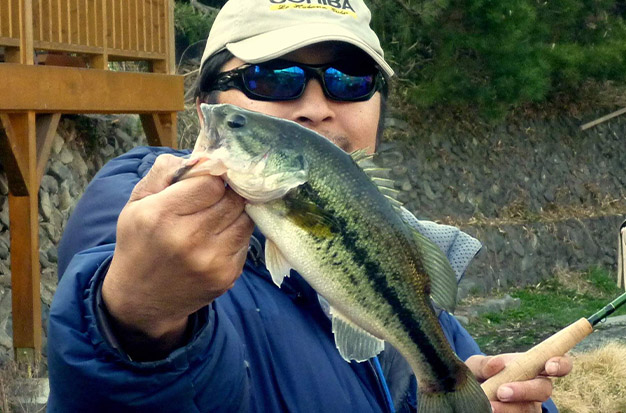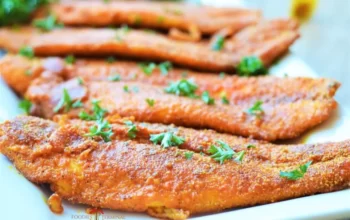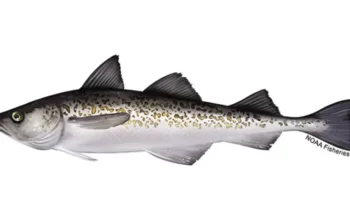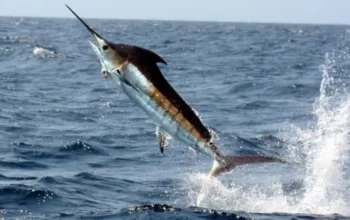How do you catch largemouth bass?
Especially when using artificial fishing lures, largemouth bass is one of the most thrilling fish to catch. They fight fiercely, strike viciously, and frequently perform breathtaking acrobatic leaps out of the water.
Millions of anglers pay them attention every year, making them one of the most well-liked gamefish in the world. Bass fishing has its own tournaments, TV shows, podcasts, video games, and more. Fishing for largemouth bass costs millions of dollars every year and consumes countless hours.
Table of Contents
About Largemouth Bass
AKA: Black bass, green trout, bigmouth bass, lineside bass
In the US, this species is thought to be the most widely consumed gamefish. Largemouth bass fishing tournaments have become very popular in recent years.
Appearance
The lower jaw of a largemouth bass extends past the outer corner of the eye.
It has a dark green upper body, silvery sides and belly, and a dark stripe running down its middle. . Light green to nearly white are the colors of the underside. They have a nearly divided dorsal fin with the anterior portion containing nine spines and the posterior portion containing 12 to 13 soft rays
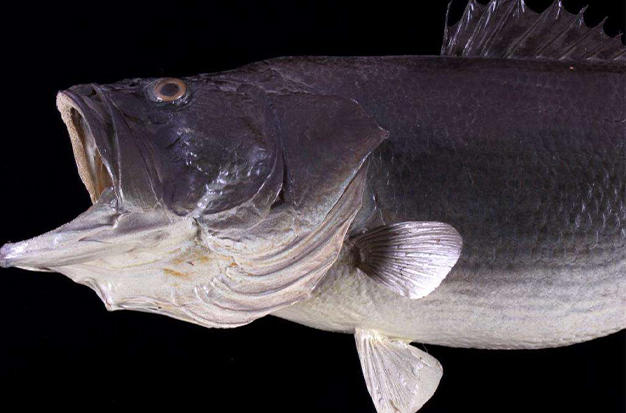
Size
Over 20 pounds have been recorded for largemouth bass.
Distribution
You can locate largemouth bass in the St. Lawrence, Great Lakes, Hudson Bay (Red River), and Mississippi River basins; Atlantic drainages from North Carolina to Florida and to northern Mexico. The species is now widespread due to its extensive introduction as a game fish.
Habitat
In all types of waters, from brackish (a mix of fresh and saltwater) to freshwater, largemouth bass can be found. They prefer broad, slowly flowing rivers and streams with supple bottoms.
They particularly enjoy clear water. Although young largemouth bass may prefer to group together in schools, adults typically live alone. Occasionally, many bass will congregate in a small space without interacting. Largemouth bass seek protective cover such as logs, rock ledges, vegetation, and man-made structures. They do well in a variety of habitats but prefer calm, clear water.
Food
Largemouth bass is ravenous carnivores that consume insects, frogs, gizzard shad, sunfish, minnows, and occasionally snakes. The top predators in the aquatic ecosystem are adult largemouth bass. Fry feed primarily on zooplankton and insect larvae. They start acting as active predators when they are two inches long. Adults consume primarily other fish and large invertebrates like crayfish. Bass that are smaller is eaten by larger fish. In shallow waters, adult fish feed close to aquatic plants.
When Are Largemouth Bass Most Active?
As cold-blooded creatures, bass is most active in warm water. Bass has faster metabolisms in warm water, which means they must consume more food to maintain their energy levels. They are simpler to catch when they are eating.
Seasonal and temperature variations have a big impact on where and how active bass are. They become much more active and easier to catch in shallower water in the spring and early summer as a result of the warming water.
Bass are still active during the sweltering summer months, but they usually move to deeper water. Largemouth bass can once more be found in shallower waters as autumn approaches and the water starts to cool. Bass is less active in the winter because the water is colder, but they are still catchable.
What Time Of Year Is Ideal For Largemouth Bass Fishing?
Largemouth bass fishing is typically best in the early morning (dawn to 8:00 AM) and evening (5:30 PM to dusk), though this is by no means a strict rule.
Bass are primarily visual predators, using their keen vision to locate and catch prey. The fact that they can see better in dim light than the majority of the prey they hunt is one of the reasons why early in the morning and late at night are typically preferred times for fishing. Bass has the ability to ambush their prey without being seen.
What Is The Ideal Largemouth Bass Bait?
Fish (such as shiners, minnows, or shad) and crawfish are excellent choices for live bait because bass typically eats these.
Since largemouth bass is carnivorous, the most effective artificial baits frequently resemble their prey in some way.
In addition to attacking a variety of artificial baits, bass is ferocious predators. The most popular lures don’t all exactly resemble the natural prey of bass, which is something you’ll notice if you look at them. The important thing is that each lure has a distinct characteristic that draws bass, like flashing in the light.
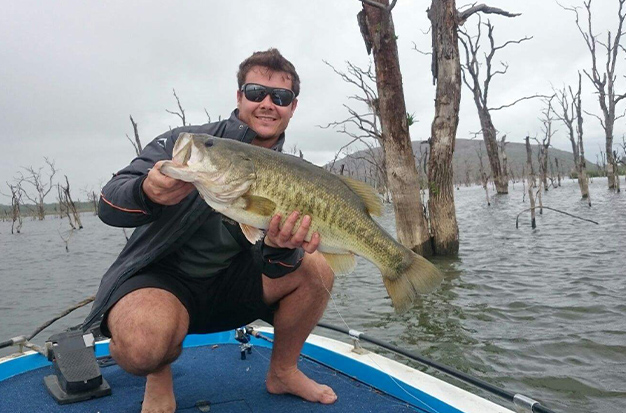
How To Catch Largemouth Bass?
Realize That There Are No Magic Bass Lures
Success in bass fishing doesn’t begin inside your tackle box. You must broaden your attention beyond lure choice to include the entirety of the bass’s habitat. Examine how bass interacts with the cover and structure that are available to them throughout the year and in various environments. When and where do bass spawn? What are their seasonal foraging movements and what do they eat? You can choose the right lures and presentations based on the answers to those questions.
Learn To Use A Variety Of Bass Lures Effectively.
You should be able to fit your essential toolkit into a compact tackle box. Spinnerbaits, shallow- to deep-running crankbaits, plastic worms, topwater lures, jerk baits, weedless jigs and jig trailers, jigging spoons, and a soft weedless frog or rat—one for each kind of bass habitat—could all be included. These lures give you other options for success if your confidence bait doesn’t work. Increasing your basic lure selection should be done with caution because doing so dilutes proficiency.
Master One Versatile Bass Lure
If you enjoy fishing quickly, a spinner bait is a good lure to learn how to use. Bass Pro Shops
The lure you select should fit your personality. When fishing aggressively, a spinner bait is a good option. Texas-rigged worms or jigs are frequently used by meticulous casters. Although some skilled bass fishermen prefer crankbaits, jerk baits, or even topwater plugs as their counterpart fishing lures, you’ll get better results if your chosen lure can cover water from the shallows to the depths. Whatever lure you choose, understand every subtlety of it to boost its potency.
Stick With Basic Lure Colors
Some tried-and-true lure color options include chartreuse-and-white spinnerbaits with gold and nickel tandem blades, Firetiger and Tennessee-Shad crankbaits, and black-and-blue jig-and-pig combinations, Junebug worms for murky water, Watermelon-Seed worms for clear water, and both silver and gold jerkbaits with black backs.
Remember that a pumpkinseed worm is unlikely to succeed where, say, a purple plastic worm failed to attract strikes. As an alternative, try a different lure or location. Significant adjustments produce significant outcomes. Color switching might prove useful once you start catching bass, though.
Tune Into The Weather
Adapt your fishing strategy and location to the conditions at hand. Bass typically attacks when it is windy or cloudy outside. Their strike zone widens and they become more receptive to aggressive presentations. A spinnerbait or other lure that quickly covers water will probably draw strong strikes.
Bass activity is reduced and the strike zone is smaller due to high pressure and a clear sky. Give bass plenty of time to react as you dissect the cover with worms or jigs. Throughout the day, be aware of the weather. Even a small change, like a light breeze after an extended period of complete stillness, can make passive bass become aggressive feeders.
Break The Habit Of Fishing The Same Spots
You must leave the path leading nowhere before you can embark on the journey to bass nirvana. Fishing in well-known locations is unpredictable and doesn’t force you to think through all of the possibilities that might produce better catches. When the conditions are right, only use your tried-and-true fishing spots. Every fishing trip should include some time for exploring new areas and trying out new techniques. You won’t improve as a fisherman unless you increase your understanding of habitat and how bass relates to it.
Don’t Be Led Astray By Other Bass Anglers
You might be tempted to copy what someone else is doing if you aren’t getting any bites. Although the fisherman in the middle of the lake might seem to be on to something, he might not have received a bite all day. Make an effort to identify your own fishing patterns.
Dock talk in particular should be avoided. People who boast loudly about their bass fishing prowess are typically just blowing smoke. Good fishermen are usually very private. You already have all the equipment you need to catch bass, but your mind is the most effective one.
Don’t Be Afraid To Make Bold Choices
You only need to choose one of many workable solutions; you are not required to find the theoretical best pattern. Be prepared to take risks when a particular approach doesn’t seem to be the best option but actually proves to be ineffective. For instance, you might be able to attract bass to a topwater plug if they ignore worms and other bottom-bouncing baits. Or, if the lower end of an impoundment’s deep dropoffs and ledges are ineffective at producing bass, think about running very far up a significant tributary and fishing shallow cover in murky water.
Mix Up Your Presentation Until Bass Starting Hitting
Bass is questioned by every cast member: Would you like this? You keep asking the same question when you fish a lure in the same manner repeatedly. The response is an emphatic “No!” if you aren’t getting strikes.”
Something as subtle as letting a spinnerbait drop 6 inches next to the shaded side of stumps instead of making a steady retrieve or dragging a worm on the bottom as opposed to hopping it can mean the difference between a big catch and meager results. Give bass choices, and they’ll let you know what they want.
Glean The Most From Every Bass That Strikes
Aware of the entire fishing environment and focused on your lure at the same time is how you should be thinking. If you lose focus, you’ll pass up soft bites and crucial cues. You need to gather all the information you can when a bass strikes, especially the first fish of the day. In relation to the cover or structure, where was the lure? When the bass hit, what exactly was the lure doing? A pattern that will have you catching fish all day—and one that you can add to your list of successful presentations in the future—can be identified by keen awareness at this crucial moment.
Conclusion
Every type of fisherman, from the novice to the seasoned pro, finds satisfaction in bass fishing. Even novice anglers can catch them with great success because they are so aggressive. Yet they’re also smart enough to give professional anglers a challenge.
Don’t hesitate any longer. Get outside and catch some largemouth bass! Book with one of our guides if you don’t know how to catch a bass.

